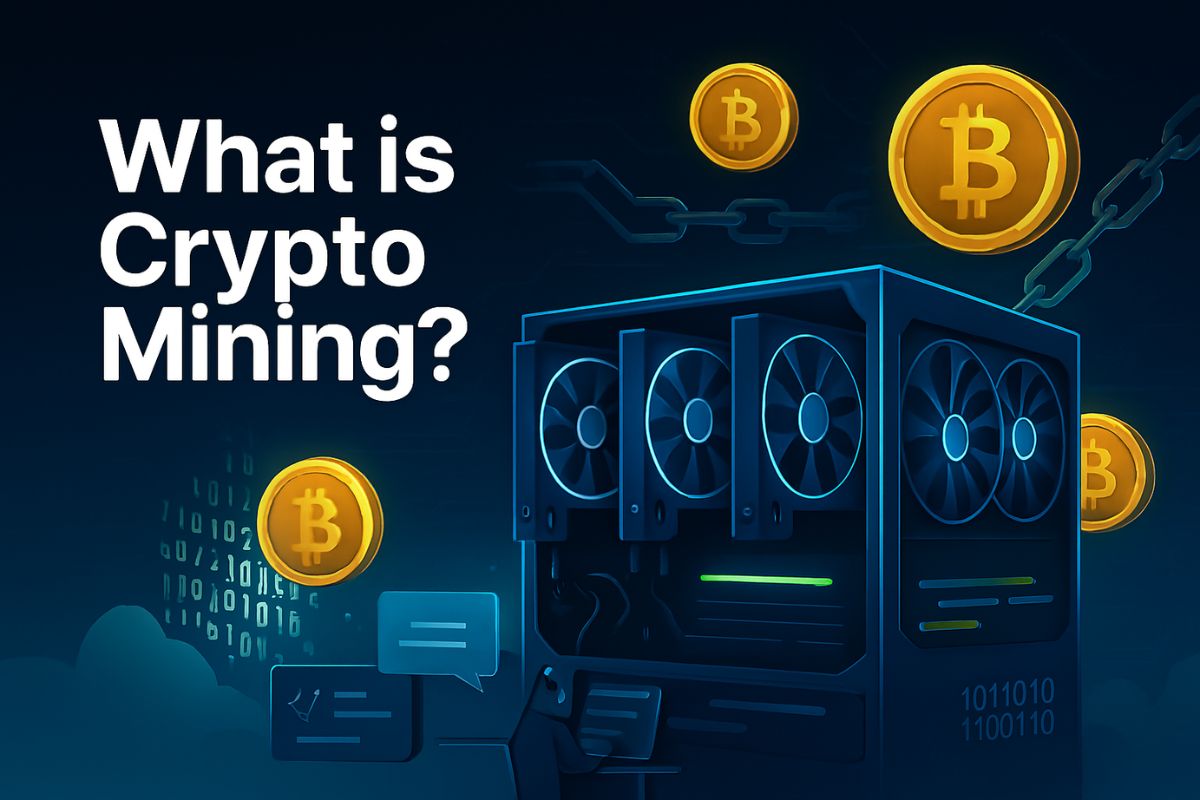Crypto mining is the process of verifying blockchain transactions and adding them to a distributed ledger using powerful computers and cryptographic algorithms. This guide explains what crypto mining is, how it works, its benefits, risks, hardware requirements, environmental impact, and the future of mining in 2025 and beyond.
Cryptocurrencies like Bitcoin, Ethereum, and Litecoin have taken the financial world by storm—and at the core of this revolution is a fascinating process known as crypto mining.
Whether you’re a curious beginner or an aspiring investor, understanding how crypto mining works is crucial. It’s not just about earning coins; it’s the very mechanism that keeps blockchain networks secure, decentralized, and operational.
In this blog, we’ll break down everything you need to know about cryptocurrency mining: how it works, why it matters, its benefits and drawbacks, and how the landscape is changing in 2025.
What is Cryptocurrency Mining?
Cryptocurrency mining is the process of verifying transactions and adding them to a blockchain ledger using computational power. It also involves solving complex cryptographic puzzles that validate blocks and secure the network.
In return, miners are rewarded with newly minted crypto coins (like Bitcoin) and transaction fees—a process known as the Proof of Work (PoW) consensus mechanism.
How Does Crypto Mining Work?
The Step-by-Step Mining Process
- Transaction Initiation
A user initiates a transaction (e.g., sending Bitcoin). - Transaction Broadcast
The transaction is broadcast to a network of computers (nodes). - Block Creation
Transactions are bundled into blocks by miners. - Proof of Work Puzzle
Miners compete to solve a cryptographic puzzle using computational power. - Block Validation
The first miner to solve the puzzle broadcasts the solution to the network. - Consensus
Other nodes verify the solution. If valid, the block is added to the blockchain. - Reward
The miner receives a block reward in the form of cryptocurrency + transaction fees.
Types of Mining
| Mining Type | Description | Example Coins |
|---|---|---|
| CPU Mining | Uses a computer’s central processing unit | Early Bitcoin |
| GPU Mining | Uses high-end graphic cards for better speed | Ethereum (pre-2022) |
| ASIC Mining | Application-Specific Integrated Circuits | Bitcoin |
| Cloud Mining | Renting hash power via third-party providers | BTC, LTC |
| Mobile Mining | Mining via mobile apps (not profitable at scale) | Testnets |
Key Benefits of Crypto Mining
1. Financial Rewards
Mining can be highly profitable when done efficiently. Successful miners earn both block rewards and transaction fees.
2. Supports Blockchain Networks
Miners ensure that transactions are verified, making the network trustworthy and decentralized.
3. Decentralization & Security
Crypto mining removes the need for a centralized authority like banks. It distributes power among participants.
4. Technology Adoption & Innovation
Crypto mining has driven advances in computer hardware, cooling systems, energy solutions, and parallel computing.
What Equipment Do You Need to Start Mining?
| Equipment | Purpose |
|---|---|
| Mining Rig | Includes GPUs or ASICs to perform hashing |
| Motherboard | Supports multiple GPUs |
| Power Supply (PSU) | Provides energy to all components |
| Mining Software | Helps manage and track mining activity |
| Digital Wallet | Stores your cryptocurrency safely |
| Cooling System | Keeps equipment from overheating |
| Stable Internet | Constant connectivity to the network |
Popular mining software includes: CGMiner, NiceHash, BFGMiner, EasyMiner
The Economics of Crypto Mining
1. Block Rewards
As of August 2025:
- Bitcoin block reward: 3.125 BTC (after 2024 halving)
- Ethereum: Now uses Proof of Stake (PoS), no mining rewards
2. Mining Difficulty
Networks automatically adjust mining difficulty to maintain block time intervals. This ensures stability and fair competition.
3. Mining Pools
Instead of mining solo, many users join mining pools to combine resources and share profits.
Popular pools:
- AntPool
- F2Pool
- ViaBTC
Environmental Impact of Mining
The Energy Debate
One of the most controversial aspects of crypto mining is its high electricity consumption.
Bitcoin mining alone consumes more electricity than some countries. This raises concerns about:
- Carbon emissions
- E-waste from hardware
- Heat generation
Sustainable Solutions
- Renewable Energy Mining: Solar, hydro, wind-based operations
- Carbon-Neutral Crypto Projects: Chia, SolarCoin, etc.
- Green Mining Incentives: Tax breaks, carbon credits
Legal and Regulatory Challenges
Crypto mining is legal in many countries but restricted or banned in others due to energy usage, tax issues, or policy concerns.
| Country | Mining Status |
|---|---|
| USA | Legal (regulated by state) |
| China | Banned (since 2021) |
| Russia | Restricted |
| Kazakhstan | Regulated (licenses required) |
| El Salvador | Legal + government-supported |
Risks of Crypto Mining
1. High Upfront Costs
- ASIC miners can cost ₹2–5 lakhs or more.
- Electricity bills can eat into profits quickly.
2. Price Volatility
- If crypto prices crash, mining becomes unprofitable.
3. Hardware Obsolescence
- Mining equipment becomes outdated fast.
- New ASICs/GPU models replace older versions quickly.
4. Security Threats
- Mining farms can be targeted by hackers, malware, or physical attacks.
5. Regulatory Risks
- Sudden bans (like in China) can shut down mining overnight.
Future of Crypto Mining in 2025 and Beyond
1. Shift to Proof of Stake (PoS)
- Ethereum has already moved from PoW to PoS.
- Other coins are expected to follow, reducing mining opportunities.
2. Mining-as-a-Service (MaaS)
- Cloud mining services are making mining more accessible, even for mobile users.
3. AI Integration
- AI is being used to optimize mining performance, temperature control, and profitability predictions.
4. Decentralized Mining Networks
- Projects like Helium use IoT devices for lightweight, decentralized mining operations.
5. Regulatory Clarity
- Governments are now establishing crypto taxation and mining laws, bringing legitimacy to the sector.
Expert Tips to Start Mining
- Start small with GPU rigs before investing in ASICs
- Use mining calculators to estimate ROI
- Choose coins based on energy-efficiency and demand
- Join mining communities or Discord groups
- Always use surge protectors and cooling setups
- Stay updated on regulatory changes
Common Mistakes to Avoid
- Mining without calculating costs vs. rewards
- Ignoring cooling and ventilation needs
- Using outdated or low-efficiency hardware
- Joining unverified or scammy cloud mining sites
- Storing coins without wallet security
FAQs
1. Is crypto mining still profitable in 2025?
Yes, but it depends on your hardware, electricity costs, and which coin you mine.
2. What is the best cryptocurrency to mine right now?
Bitcoin (via ASIC), Kaspa, and Litecoin are still profitable. Others like Monero are ASIC-resistant.
3. Can I mine crypto on a mobile phone?
Technically yes, but it’s extremely slow and unprofitable. Not recommended.
4. What is a mining pool?
A group of miners combining resources to increase the chances of mining a block and sharing rewards.
5. Is crypto mining legal in India?
As of now, it is not illegal, but the government monitors crypto transactions and taxation closely.
6. What is the best software for mining?
Popular tools: CGMiner, NiceHash, BFGMiner, EasyMiner
7. Will mining end one day?
Yes, for some coins like Bitcoin, the last BTC will be mined around the year 2140. Other coins may switch to PoS.



